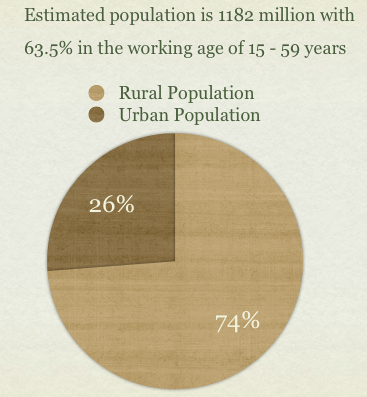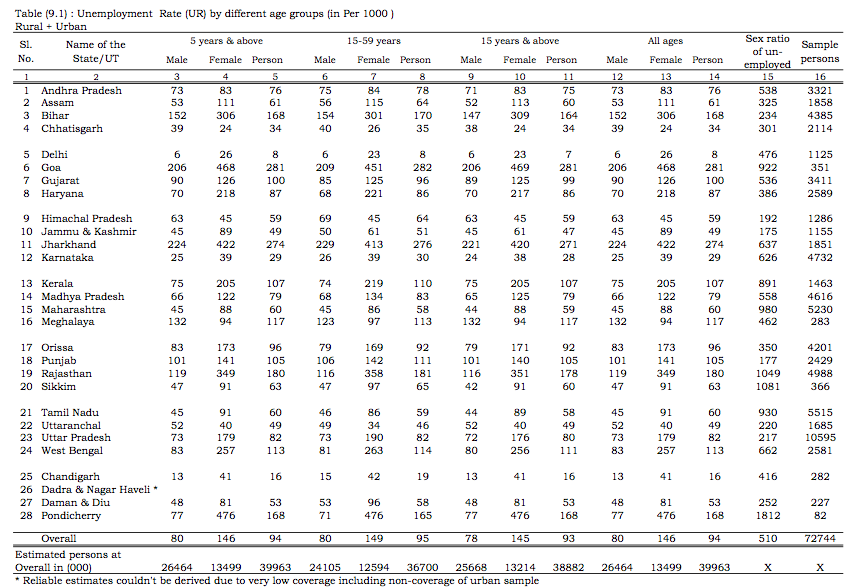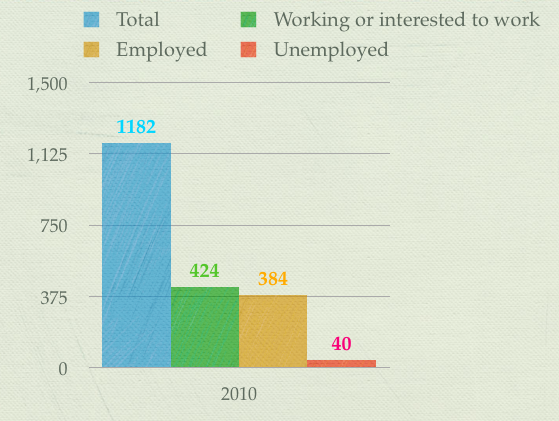For the first time ever – the Labour Bureau of the Government of India has conducted a survey on employment – unemployment, and has come up with an unemployment rate based on that.
National Sample Survey Organization (NSSO) also calculates unemployment rates, but these surveys are done with a gap of 5 years, so there is a dire need to have unemployment numbers in between.
The Labour Bureau has started these employment – unemployment surveys, and I hope we will have more frequent numbers on a measure as important as employment. The report (pdf) itself is quite detailed, and I was really impressed with the content and personally, I think this is a great first step. The report contains a whole section on shortcomings of their survey methodology, and that tells you that the quality of the data is only going to improve going forward.
Now, let’s take a look at some of the numbers that were generated by the report.
40 Million Unemployed with an Unemployment Rate of 9.4%
The survey was conducted in 28 States/UTs spread across the country in which about 99 per cent of the country’s population reside.
It estimates that the population of the country is 1182 million with 63.5% in the working age of 15 – 59 years, however, not everyone who is in the working age is interested in joining the work force, so the worker population ratio is much lower. There are an estimated 238 million households, of which 172 million are rural and 66 million are urban. Out of the total population of the States/UTs covered, 872 million persons (73.8 per cent) live in rural areas and 310 million persons (26.2 per cent) live in urban areas.

The overall unemployment rate is 9.4%, and it is split out as 10.1% in rural areas, and 7.3% in urban areas. Now, a key thing to remember about unemployment rate is that it is calculated as a percentage of labor force, and not the total population. So, this means that 9.4% of that part of population which is interested in working is unemployed, and not 9.4% of the entire population is unemployed.
In the Indian context, – 359 persons per 1,000 are either working or interested to work, and this is called the Labor Force Participation Rate.
So, out of an estimated population of 1,182 million – 424 million persons are either employed or are interested in working.
The unemployment rate of 9.4% means that out of those 359 persons per thousand, or 424 million people – there are 9.4% or about 40 million who were unemployed. Here are the numbers in millions.
For males, the unemployment rate is 8%, whereas for females the unemployment rate is 14.6%. The rural unemployment rate is 10.1% and the urban unemployment rate stands at 7.3%.
One thing to be noted about this unemployment rate is that the report states that compared to the NSSO survey the unemployment rate is quite high probably due to under-estimation in the agriculture sector employment.
From the report:
Comparison of Labour Bureau’s present survey results for the year 2009-10 with NSSO’s Employment-Unemployment survey results for 2007-08, reveals that the unemployment rate derived on the basis of the Bureau’s survey is quite high. Higher unemployment rate may be parting attributed to as much as 10 per cent difference in the contribution of agriculture sector to total employment estimated in the present survey vis-à -vis the NSSO 2007-08 survey estimates. While the shift of workforce from agriculture to other sectors is a positive trend for a fast growing economy, the steep reduction in lower share of agriculture employment based on the Bureau’s survey could be attributed to lack of adequate probing skills of the Contract Investigators.
There could be some underestimation in the agriculture sector employment due to lesser-probing by the contract investigators especially in case of women workers who tend to be employed more casually in the agriculture and allied sectors such as forestry, livestock and fisheries.
Since this is the first time – it is understandable that there are some limitations, and personally I feel that this is a great start, and I hope that with time these reports become a monthly affair and India can get frequent unemployment numbers like the US too.
Getting unemployment numbers is really important to assess how various employment schemes work, impact of global recessions, and when we allow companies like Walmart to operate in India, we will need data to see if they are creating rural jobs or rendering people in urban retail unemployed. Surveys such as these could then become key to get the right information on policy formulation. I’m only surprised that these numbers haven’t gotten more press coverage in the main stream media.
Anyhow, before I end this post let me tell you the number that really really surprised me – the state with the highest unemployment rate.
According to this survey – Goa is the state with the highest unemployment rate, and having been in Goa for a couple of years, I know it’s quite a prosperous state, so I won’t be surprised if I am reading the number wrong, but I’m going to dig deeper in the numbers and see what the real cause of that is. Stay tuned for that post, and if you’re interested in a particular state leave a message, and I’ll look at that also. In the meantime, here is the table that shows the unemployment rate for different states (click for a bigger readable picture).

Also read Unemployment Numbers in US to get a perspective on how other countries calculate this number.


Where is data for the northeast States?
Hi Manshu,
Great post.
My two cents,
First,
“…. I’m only surprised that these numbers haven’t gotten more press coverage in the main stream media…”
Actually, this should not surprise you at all. Mass media today in our country focus on capturing ‘fleeting attention’ by featuring ‘sensational quips’. Cricket, Corruption and Bollywood is the nucleus of what media revolves around. In such a scenario there is no room for in depth papers like this, no audience, no readers at the mass level. Perhaps individuals like yourself can contribute to carve a niche of readers who will be interested in understanding the root of issues rather than shoot from the hip on the basis of half baked – tip of the iceberg information.
Second, it comes as no surprise to me that Goa tops the list. The major sources of employment in Goa is fishery and forest related (of which i am assuming the products cashew and feni is on the top!), tourism (of which the tourists mostly get around goa on their own and do not depend on infrastructure or manpower) and other unorganized sectors.
To the detractors of capitalism, the writing is clear on the wall; meaningful job creation is attainable through encouraging private entrepreneurship and responsible open-doors for FII/FDI. Reliance on public sector would lead to a ‘Greece-ification’ and opposition to private capital would lead to ‘Keral-ization’ of India.
Good work
Hi! I work for Unnati, a not-for-profit that has been providing training to youth to make them employable. In the last 8 years we have trained and provided employment to over 2000 youth. Encouraged by the success of this program we are now going pan India with a vision of providing employment to a million youth by 2020.
In this context NSDC gives a number of 150 million who need to be skilled and provided employment. This in comparison to 40million unemployed doesnt sync!!!!
Pls elucidate…
Hi Meenakshi,
Apart from the possibility that the data is horribly wrong, it could be that a lot of these people are underemployed in agriculture, so although they are technically employed, they want and can do more productive jobs.
Also, I read through your website and it’s quite impressive the work that Unnati does. I was intrigued by the statement about just taking 70 days to bring one generation above the poverty line. What does that mean? I’m sorry if that was already somewhere in the website and I failed to find it.
Manshu,
I am sorry for the delay in responding to your query.
UNNATI is a catalyst that acts as a launchpad to mainstream employment for underprivileged youth. Youth from the lower sections of the society irrespective of their educational qualifications are groomed over a period of 70 days. They are trained in spoken English, basic computers, lifeskills & values and we help them realise that each individual has huge potential and they need to untap the same. They are also trained in a vocation which could either be data entry or retail sales or housekeeping or security etc. Oncampus placements are conducted towards the end of the 70day program and each youth walks out with a job in hand (avg salary range – Rs. 5000 per month).
This is an amazing transformational program for the youth. The Trust now has constituted a Section 25 company to replicate this successful program across India.
Thank you for your reply – pretty incredible stuff going on there with Unnati. I do weekend link posts where I highlight seven posts that come to my attention during the week. I’ll link to Unnati this coming weekend.
Thanks for your comment and all the best with your work.
Whatever “standard” you follow, but that means numbers are NEVER absolute. How can you make a difference between
– working and still trying to find &
– trying to find & unemployed.
Makes no sense unless that middle category is taken out.
90% of working people would love to find a “better” job!
I didn’t make these standards 🙂
Anyway, there needs to be a way to distinguish between people who don’t want to work (housewives) and people who are looking for a job but don’t currently have one. If you include everyone who doesn’t have a job even if they didn’t have one then that will have bigger issues than what’s being reported right now.
I can’t imagine the author is so confused with blowing numbers! Pie chart says 63.5% of 1182 mil are in working age. Then 9.4% of those are unemployed. Then the craziness begins: What is “working or interested to find work” mean?
To put this clearly it is:
Total population = 1000
Eligible work force = 635
About 62 people unemployed. End of the story.
– AG
Working or interested to find work indicates people who actually want to work, so students who fall between the age of 15 to 59 or home-makers in that age are not interested in finding jobs and hence they are not called unemployed.
This is standard methodology in all countries.
Why cannot these unemployed people utilized for planting new saplings and its maintenance till the plants grow old as trees and become self dependent on rains. Employed can also contribute on weekends by giving helping hand. This should give all who participated a credit while applying for new job or while switching jobs. Employers should consider such achievements. Advertise in Media to come forward and participate and their respective localities with municipal authorities. This should happen massively around world every year consecutively.. by seeking advise from experts what kind of plants would grow fast and on what soil. This would turn whole world in to beautiful Garden.
Whole World Live in Peace.
How many Unemployment in the Home of India???..where the population are 121 Crores.Today’s Youth demanding :
[Unemployment = Experience+Education+Age Factor]
Isse To Good Tha Ki Hum Kheti Karte and Non-Education Rahate
It is effecting to direct Economic factors to India as an internally position.
right, i am agree with your opinion in some website it is given that Indian economy is on the 4th rank in the world, if it will be on 4th rank then how so much people are unemployed and how can this 4th rank came. i think this information given on net that Indian economy has 4th rank in world is wrong.
Thank you for your article about unemplyment and older persons. Check out this original song on You Tube about older people during hard times.
http://www.youtube.com/watch?v=uM5HDRxwPns
Thanks,
Jim Burns
Woh….. then why there is such a huge fuss in media abt unemployment in USA, when Idian numbers are also quite high?
The way different countries measure and calculate makes it difficult to compare one with another. The US rate is high historically; if you look at this chart on US unemployment you will see a steady slope upwards, and that’s the cause of concern.
http://www.bls.gov/opub/ted/
I think Spain currently has around 20% unemployment or so, but it probably won’t be accurate to say that they have more than double the unemployment of India or US because they might be measuring it differently.
If we get regular figures in India we will also be able to track and know how the economy is doing in this important measure from one year to another.
Oh, I didnt knew that. Is there any way we can find absolute numbers for some countries to compare them unemployment-wise.
For India the absolute number according to this survey is 40 million people. For US – for the month of Oct 2010, which is the latest month – the total unemployed people are 14.2 million.
However, these two numbers are not comparable. If you look at the earlier post about Unemployment Numbers in US – I linked to at the bottom of the post – the 14.2 million is the number under U-3 which is the official US rate, however I think the way the Indian number is calculated is more comparable to the way the U-5 number is calculated in US, which is higher there.
Here is an earlier post I did about the nuances of the way US unemployment numbers are calculated.
http://www.onemint.com/2009/07/28/unemployment-number-nuances/
Actually reading about Indian survey made me realize why US calculates the number the way it does because that really gives a lot more insight to the unemployment figures.
So, you see we just took two countries and it wasn’t straightforward to compare their unemployment numbers, doing it for more countries will be even more complicated.